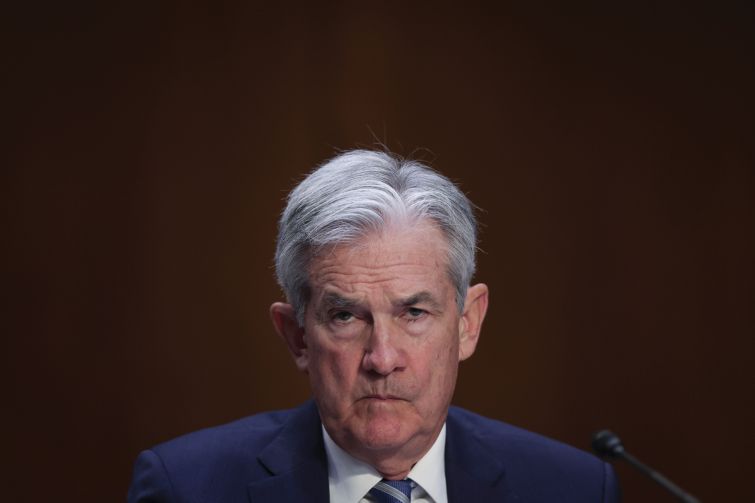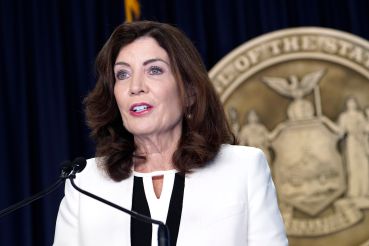Federal Reserve Interest Rate Pause Won’t Save Regional Banks: Economists
“It’s a fragile equilibrium. If you start to see people running, you’ll run too.”
By Brian Pascus June 20, 2023 3:47 pm
reprints
The much-anticipated interest rate pause by the Federal Reserve last week generated a sigh of relief across U.S. capital markets. But some economists believe a shrinking Fed balance sheet, persistently high 10-year Treasury yields, and a decline in commercial real estate office values have left the banking system vulnerable.
Federal Reserve Chairman Jerome Powell admitted as much on June 14, after he announced the first pause in 15 months of the benchmark Federal Funds Rate, which rose from 0.2 percent in March 2022 to 5.25 percent today. Powell said that a significant amount of commercial real estate distress remains in the banking system’s piping, with the balance sheets of smaller, regional banks carrying a significant swath of murky credit.
“To the extent it’s well distributed, the system could take losses,” Powell said during a press conference. “We do expect that there will be losses, but there will be banks that have [high] concentrations, and those banks will experience larger losses.”
The nation’s regional banking system has been upended this year by the failures of Silicon Valley Bank (SIVBQ) (SVB), Signature Bank (SBNY) and First Republic Bank (FRCB). Together these midsize, regional lenders carried $556 billion in assets at the time of their demise, and amounted to three of the four largest bank failures in U.S. history.
Even though the system has been spared another bank collapse since JPMorgan Chase (JPM) purchased First Republic at the behest of the Fed on May 1, there remain threats on the horizon — chief among them, the Fed’s ongoing policy of quantitative tightening, or QT.
During the pandemic, to reduce the economic fallout from lockdowns and mass unemployment, the Fed purchased large amounts of long-term U.S. Treasury bonds and mortgage-backed securities, injecting liquidity into the system and doubling its balance sheet from $4 trillion in February 2020 to nearly $9 trillion by May 2022. This strategy of quantitative easing (QE) has now been replaced by QT: selling Treasury securities on the secondary market or letting them mature without repurchase, thus reducing its balance sheet by billions.
On June 1, the Fed began selling Treasurys at a cap of $30 billion per month, which will increase to $60 billion per month by August. This move followed its yearlong $600 billion selloff that preceded the regional banking crisis and only momentarily abated during the heady days of March, April and May when the Fed guaranteed deposits at the three failed institutions.
Economist Christopher Thornberg, founder of Beacon Economics, said that the Fed’s commitment to quantitative tightening will have a negative impact on regional banks by pressuring their already shaky deposit base — mainly because of the one-to-one relationship between the Fed’s balance sheet and deposits in the banking system.
“When the Fed buys Treasurys … that money eventually finds its way into the banking system,” Thornberg explained. “The opposite occurs with QT: You’re selling off bonds into the bond market, and when someone buys bonds from the Fed they give cash drawn from the bank, they take that cash, the cash comes out of deposits.
“In theory they will continue QT, which is around $90 billion a month in terms of getting rid of assets. And if they do that again, the deposits will start falling again as the Federal Reserve balance sheet falls, and that will put more stress on the banking system, simply because they’ll have to sell off assets at a loss,” he added.
Moreover, this gradual selloff of Fed Treasurys will enter an overly saturated marketplace for U.S. bonds — and following the golden rule of economics, with more supply in the marketplace, people will pay less, pressuring Treasury yields higher to make up for the decline in bond values.
Tomasz Piskorski, professor of real estate finance at Columbia Business School, said the key rate to watch here is the 10-year Treasury yield, which stands at 3.77 percent, down slightly from 4.07 percent on March 2. The 10-year yield is an important CRE industry indicator because “a vast majority of CMBS loans are on 10-year maturities,” and the decade-long framework is a commonly used benchmark for pricing CRE credit, according to Piskorski.
10-year Treasury yields were as low as 2.6 percent in August 2022, shortly after the Fed began its initial round of quantitative tightening in mid-2022. It has remained locked between 3 percent and 4 percent since that August 2022 nadir.
“3.7 percent is still very high relative to what it was,” Piskorski said. “As long as it stays in the 4 percent area, then the fundamental potential insolvency issues in the banks remain: the value of the [bank] assets are still worth significantly less than they were in the beginning of 2020.”
And this brings us to the rub of the trillion-dollar economic equation: Higher interest rates mean assets are generally worth less over time, and high interest rates are generally bad for banks because they finance their long-duration assets with short-term deposits.
Many of these deposits have financed hundreds of billions of dollars in CRE loans — specifically office loans — many of which are gradually losing value even as they are set to mature, largely due to a post-COVID secular restructuring in how and where people work.
In the eyes of Professor Robert Hockett, who teaches corporate law and financial regulation at Cornell Law School, interest rate hikes have lowered the value of Treasurys the banks carry in their portfolios, and they have also lowered the value of commercial real estate and made it harder for sponsors to refinance on properties that have seen sharp decline in value from the time of their original loans. This in turn has put the entire banking system in a bind that is similar to the once it faced during the 2006 to 2008 period prior to the Global Financial Crisis of 15 years ago.
“The loans themselves don’t have to be paid off right off the bat, but it’s difficult for those who borrow for commercial real estate to stay current with their payments to the banks,” Hockett explained. “As the likelihood of defaults by borrowers rises, which will rise as [CRE] prices fall, that means risk grows for lenders themselves who are dependent on being paid back.
“It’s a bit like 2008 all over again,” he added. “Those who had borrowed to buy those expensive houses were increasingly underwater, and as those mortgage borrowers faced worse prospects, then their lenders began to suffer.”
Hockett noted that the 2000s housing bubble first burst in 2006, and that it took two years for the ramifications to insidiously make its way into the balance sheets of Lehman Brothers, Washington Mutual and hundreds of smaller banks.
So while an interest rate pause is now in place, the system still remains at risk.
“We’re not out of the woods,” Piskorski said. “It’s a fragile equilibrium. If you start to see people running, you’ll run too.”
Brian Pascus can be reached at bpascus@commercialobserver.com


